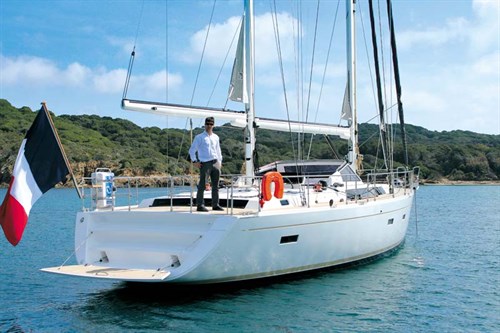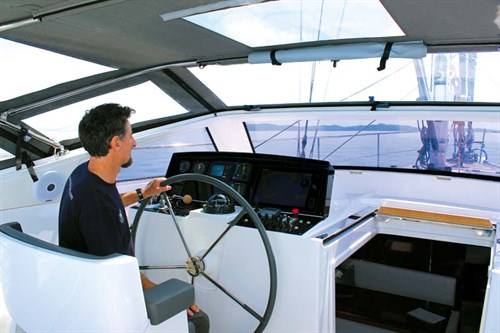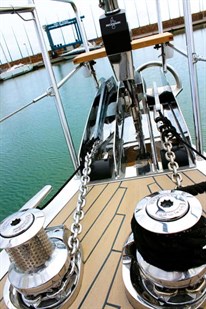The Amel 55 is a dedicated cruising sailing yacht with lots of innovative engineering including joystick-controlled sail handling and protected central cockpit.
Amel has many thousands of bluewater miles below its sturdy keels, so is a favoured yacht among long-term voyagers, as Australians may find out with the recent appointment of Vicsail as its local agency. The renowned French yard, based on the rugged west coast at La Rochelle, has been producing quality cruisers since 1968 when founder Henri Amel created an easy-to-sail yacht that would induce his wife to enjoy voyaging.
AMEL 55
The Amel 55 sailing yacht, launched in 2013, is an evolution of the Amel 54 but uses a new mould for the Berret Racoupeau design, which was the company’s strategy to give a more modern appeal to their traditionally conservative in-house designs. With more hatches for increased light and ventilation the 55 is intended to be better for the tropics.
Our review boat was based on the Côte d’Azur at the Hyères company headquarters, which gave me the opportunity to look at their flagship Amel 64 model along with other older models. The town of Hyères is a popular base for eastern Mediterranean boats, so would also give me the opportunity to take the Amel 55 for a mini cruise around the popular Îles d’Hyères archipelago.
The Amel is a highly automated boat – it took me a mere five minutes to set all the sails on my own using binnacle controls which is impressive and ideal for shorthanded sailing.
The heavy displacement 24t hull has a skeg-protected rudder and retractable bowthruster, while the driveshaft is integrated into the elongated cast iron keel. The wide stern section includes a large swimplatform with optional davits, while the 64 has a dinghy garage. Another seaworthy feature is the four watertight bulkheads in the hull and a deep engineroom well.
ENCLOSED COCKPIT
The enclosed cockpit on our review sailing yacht was the canvas-top Cabriolet version but there’s a GRP hardtop option too which would be my choice for world cruising. Inside, with 12mm Plexiglass screen forward and clear plastics all around you are very snugly looked after, but the warm test day persuaded me and my host Vincent to unclip it to enjoy the sunshine.
The deep cockpit has all lines running into it, including access to the mizzen sheets and winches. The main console bristles with electronics – Furuno radar and autopilot, B&G Hydra H3000 plotter and second autopilot, Lewmar chain counter, engine controls and more – but the most unusual item is the bank of joystick controls for the sails.
The entire ketch rig is controlled from here, as I demonstrated with my five-minute hoist of main, genoa and mizzen sails once clear of the harbour. Harken winches and blocks are used throughout, plus jammers on many lines allowing multiple controls, and the ketch rig allows an even spread of sail area across the genoa, staysail, mainsail and mizzen.
MOULDED DECK
The moulded non-slip is an unusual feature of the Amel deck so, unlike teak, it won’t require replacement. It felt sure underfoot and yet more security is available from the tubed stainless steel handrail when walking forward.
At the bow are large double rollers with an integrated water system for cleaning the rode and two Lewmar windlasses with capstans ensuring good backup. For trade-wind sailing a carbon bowsprit can fit into the port roller and like most things on the Amel 55, the cleats are oversize, including midships. Behind the windlasses lurks a man-sized sail locker which also houses the drop-down bowthruster, while the hawsepipes means the anchor chain won’t catch on anything.
Looking at the ketch rig with its Swiss-made alloy spars, the genoa and staysail have quality Reckmann electric furlers with manual overrides by the winch handle. The electric main mast furler system can also be manually operated by unbolting two fixings to allow non-electric operation; this manual override is a feature on many parts of the Amel 55.
Other good points include halyard locks on the mast creating a tidy mast base without the Dyneema lines flailing around, while line lockers around the aft decks also add to the tidiness that is another feature throughout the Amel.
HULL
Prolific French designer Olivia Racoupeau has created a sleek hull with tall topsides to maximise volume while retaining the trademark integrated keel gearbox system unique to Amel.
Construction is balsa sandwich with solid GRP underwater. The mast shrouds use tie rods to connect to the GRP/wood hull grid for rigidity. The new mould for the 55 has placed the skeg-hung rudder farther aft than on the 54, which is intended to give a more balanced helm. For strength, both the skeg and keel fin are part of the mould, with the cast iron bulb added later – giving a rather modest ballast ratio of 27 per cent – but is largely in keeping with the conservative sail plan.
The cockpit sole with table is lifted easily on gas-assisted struts to reveal a cavernous engineroom. Stepping onto the footplate of the 110hp Volvo Penta engine brings you down into a very organised space, with Cummins Onan 7.5kVa generator to port and both 12 and 24V power available. Other equipment includes the Dessalator brand 250lt/h watermaker. All filters and electrics are located up high for easy access.
The five-cylinder Volvo Penta is mounted backwards and connects via a ZF gearbox to Amel’s through-keel drive system and onto a short shaft to run the three-bladed folding propeller. There’s even a shaft lock to avoid wear. Thick soundproofing is effective, as I found out when underway.
PERFORMANCE
At nearly 30t fully loaded, the Amel 55 sailing yacht has to be treated with a bit more foresight than say, a 20t Sense 55, so I was relieved to reach clear water and open the electronic throttle. The positive but slightly clunky gearbox did its job and we reached an impressive top speed of 10.1kts with the Volvo turning at a sedate 2600 revs before settling back to a more economical 8.7kts at 1500rpm. With Vincent stowing the fenders in the cavernous transom lazarette, I prepared to hoist the sails to catch the light breeze that would take us all the way to the croissant-shaped island of Porquerolles for our lunchtime anchorage.
So with my finger on the ‘grand-voile’ joystick the main speedily unwound, while my other hand readied to hit the trim button. The genoa and mizzen went up in similar fashion. We were sailing – and I hadn’t left the cockpit.
The armrest seat was a comfortable perch to steer from as I edged the Amel onto the wind while trimming the Incidence Hydranet sails. The mechanical steering felt a wee bit heavy and lacking feeling so, at this juncture, most skippers would click the Furuno Navpilot 711 and sit back with a drink, but alas I was here to do other manoeuvres with the Amel 55.
Nearing a small islet, a tack was needed, so half the genoa was wound in while I turned the stainless steel steering wheel to point our bows east – Vincent helped with the lazy sheets on the genoa winch. I could have done it all by myself – the spread of canvas across the ketch rig means no single sail is unmanageably large.
“Henri Amel said if you could lift 30lb you could handle his boats,” laughed Vincent as we glided along at 4.2kts in the light 8.5kt breeze while hard on the wind at 35 degrees. Not the ideal day for this heavy cruiser, but running in the Atlantic trade winds with twin headsails up, the Amel 55 would be right at home.
Gybing required a little more effort, with the mizzen sheet manually set, but the heavy displacement hull ensured that everything was done at a leisurely pace.
Passing by Fort du Langoustier and nearby lighthouse brought us into the pristine bay at Porquerolles, which was my signal to click the joysticks and furl all the sails before dropping the anchor in 10m of crystal clear water, while watching the Lewmar chain counter reel out 30m of stainless steel chain.
The deep bilge revealed the yacht’s cache of local rosé wine which went nicely with our lunch… and the aft sunpads and lowered swimplatform looked the ideal place to wile away the afternoon but alas, there was more work to do with the Amel, as I wanted to see if it would go backwards. Being keel-mounted, the three-blade folding propeller is so far back from the skeg-supported rudder it doesn’t create backwash in forward motion, so I wondered what would happen going astern.
Once underway I executed some manoeuvres – sure enough, the momentum of the heavy yacht kept her steady but she eventually slewed off going aft as the water flow pushed the large rudder hard over.
Watching me with a smile on his face Vincent then explained the solution which was to centralise
the rudder and simply use throttle and bowthruster to maintain a straight line backwards. During a thorough week-long handover the company goes through this type of thing – which reflects the care Amel takes.
So obedient became the Amel 55 under these controls that I had no hesitation in taking her back through the busy marina and berthing aft-to.
THE VERDICT
An evolution of the bluewater-proven Amel 54, the Amel 55 is a strongly-built dedicated cruising sailing yacht with lots of innovative engineering including joystick-controlled sail handling and protected central cockpit.
See the full version of this review in Trade-A-Boat #456, August / September 2014. Why not subscribe today?
AMEL 55 SPECIFICATIONS
PRICED FROM
Amel 55 price: $2,000,000 (incl GST)
GENERAL
MATERIAL GRP
TYPE Keelboat sailing boat
LENGTH 17.3m
BEAM 4.99m
DRAFT 2.2m
WEIGHT 21,500kg (dry)
BALLAST 5900kg
CAPACITIES
PEOPLE (NIGHT) 6
FUEL 900lt
WATER 800lt
ENGINE
MAKE/MODEL Volvo Penta
TYPE Five-cylinder diesel with keel-integrated shaftdrive
RATED HP 110
SAILS
MAINSAIL 47m²
GENOA 47m²
MIZZEN 29m²
STAYSAIL OPTION 22m²
FOR FURTHER INFORMATION
ORAKEI YACHT SALES
Orakei Marina Office, Pier D, 12 Tamaki Dr,
Orakei, Auckland, NZ
PHONE 09 524 8444 or 021 92 95 92
EMAIL sales@orakeimarina.co.nz
Photography: Kevin Green















